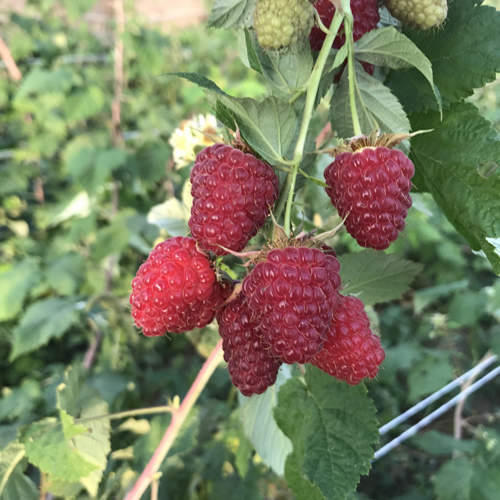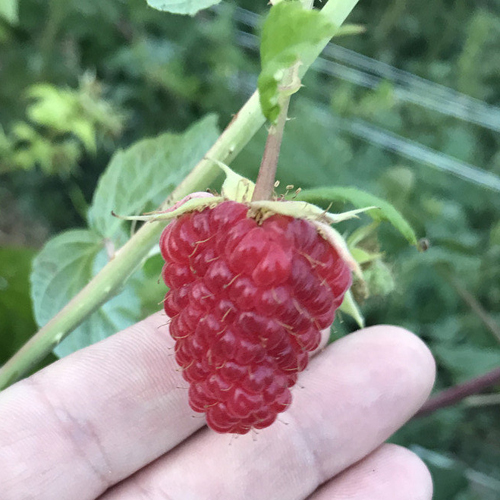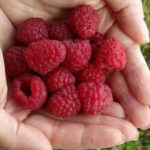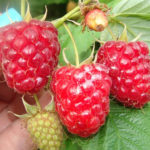Raspberry variety Caramel
Despite the widest variety of varieties of horticultural crops with a wide variety of gastronomic, aesthetic and economic characteristics, the selection work on them does not stop. Many researchers, both in our country and abroad, are making efforts to develop new hybrid forms, the properties of which would be an order of magnitude better than those of the currently existing varieties. One of these very promising breeding novelties is a raspberry called Caramel. Having just been born, she quickly and successfully completed the state variety testing, and after being included in the State Register of Breeding Achievements of the Russian Federation in 2016, she received the official right to be called a variety, and was admitted to industrial cultivation throughout the territory of our country. By the way, quite a few other varieties of raspberries can boast of such a wide zoning, and this fact is indisputable evidence of the excellent plasticity of our heroine and her adaptability to a wide variety of soil and climatic conditions.

The work on the variety was begun at one time by a talented domestic researcher, a recognized specialist in culture, a world-renowned scientist and Honored Scientist of the Russian Federation Ivan Kazakov. He was co-authored by Doctor of Agricultural Sciences, Professor Sergei Evdokimenko, as well as the heads of the Nizhny Novgorod fruit nursery "School Garden" Vladimir and Ilya Shiblev.
The main advantage of Caramel over previous generations of raspberries is its excellent dessert taste, for which it actually got its name. The sweetness of the fruit is sometimes so high that some sophisticated tasters call it almost sugary. However, most experts recognize the taste of the variety as very high, and according to this indicator, it is considered one of the best in the domestic variety of culture.
In addition, our heroine belongs to the group of so-called "remontant" varieties, capable of bearing fruit not only on two-year-old, but also on one-year-old shoots, which brings with it a significant mass of additional advantages. First of all, this is an opportunity to seriously extend the period of fruiting, and hence the consumption of fresh berries, due to the long-term late summer fruiting. Also, in the case of cultivation of this raspberry in a one-year cycle, with a harvest only on one-year shoots, the phytosanitary state of the plantation improves, on which, after harvesting the fruits, all the above-ground vegetative mass is removed and destroyed along with pathogens and pests on it. At the same time, the bushes themselves acquire excellent winter hardiness, because, completely covered with a snow blanket, they are not afraid of even the most severe frosts in the cold season.
All this together determined the excitement of interest in the novelty on the part of amateur gardeners and industrialists, which, albeit on a smaller scale, is still felt, although the variety has already become very widespread. Every year the number of fans of Caramel continues to grow, as does the area occupied by it, both in our country and in the neighboring countries.

Agrobiological characteristics
Raspberry bushes are characterized by medium vigor. The shoots of the variety are erect, up to 1.7 meters high, and under favorable cultivation conditions - up to 2 meters. The stems are up to 1.5 cm thick at the base, making them look strong enough. This does not mean, however, that plants do not need support or trellis arrangement. Without a garter, they are damaged by strong gusts of wind, and also bend under the weight of the crop. Shoot-forming ability of Caramel is moderate. On average, up to 7-8 stems appear on an adult bush in spring.The color of young shoots is green, and by the end of the growing season changes to purple. No pubescence is observed on them, but there is a noticeable waxy coating on the surface. The studs are average. Downward curved, not too hard and long spurs appear in moderate numbers and are evenly distributed along the entire length of the shoots. The color of the thorns is brown, and they are located on a purple base. They do not cause great inconvenience in caring for plants and harvesting. Leaves are complex in type, three- or five-leafed. The leaf blades are medium, oval-pointed, slightly wrinkled, green, with a slightly twisted profile and slight pubescence. Petioles are relatively short, greenish. The denticles along the perimeter of the leaves are moderately sharp. Laterals on the stems begin to appear quite close to the ground surface, due to which the fruit zone occupies a significant part of the length of the shoots. The branching of fruit branches is good, and therefore up to ten or even more ovaries can form on them. Hairiness is also present on them. Unexpectedly for the remontant variety, our heroine is actively developing root shoots. This fact can be regarded both positively and negatively - in the first case, as the possibility of rapid reproduction of raspberries with their own planting material, and in the second, as additional efforts to ensure the cleanliness of the row spacings.

The variety is self-fertile,
With good care and favorable weather conditions, the gross productivity of the variety per season can reach 5 kg of raspberries from each bush. On large areas in industrial plantings, the average yield is 110-120 c / ha, however, improved agricultural technology can bring this figure to 20 tons per hectare. There are no difficulties with cleaning, because The caramel is easily separated from the fruit, on which it is located.

Ripe fruits are capable of reaching magnificent sizes up to 2.5-3 cm in length, and weighing up to 8 grams or more. Their average weight is 3.8−4 grams, the shape is wide-conical, the color is glossy, light red. Drupes are well bonded to each other and do not disintegrate even when fully ripe. The pulp of the berries turns out to be relatively dense, very sweet in taste with a strong aroma, typical of forest rather than garden raspberries.The richness of taste and aroma is best manifested in the case of growing plants in good sunlight. In the shade, and in cool, rainy seasons and in open areas, the harvested raspberries are less sugary and fragrant. As a percentage, the amount of sugars can range from 4-5 to more than 10 g / 100 ml of juice, with a titratable acidity of not more than 1.5%. The seeds in the berries can be felt a little, but this circumstance cannot spoil the impression of the general tasting characteristics of the variety, which are highly rated by most gardeners.
The use of Caramel can be very versatile. First of all, it has undoubted success in the case of fresh consumption. It also perfectly suits for sale on the market, where it instantly finds its customers due to its bright and attractive appearance, as well as strong aroma. Farmers cultivating these raspberries for sale confirm the excellent transportability of dry and dense berries, thanks to which the presentation of the crop does not deteriorate even after long transportation. In addition, the berries are well stored in the refrigerator for several days, and are also suitable for freezing, because after thawing, they retain their shape, and the loss of juice is minimal. And, finally, our heroine can serve as an excellent raw material for conservation, from which bright, rich in taste and aroma compotes, preserves, jams, confitures are obtained.
When cultivated, plants show themselves in a fairly standard way, without showing particularly outstanding advantages and disadvantages in economic terms. They adapt well to different climates and soil types, with the exception of damp, waterlogged, saline or overly acidic soils that require preliminary reclamation. Heat resistance and drought resistance of the variety are medium, which means the ability to withstand intense heat or lack of moisture only for a relatively short period of time. Caramel is also not distinguished by its high resistance to diseases and pests, and therefore its cultivation should take place using standard protocols for protection against pathogens. They do not tolerate thickened raspberry bushes, as a result of which their growth strength decreases and the shoots become thinner. The author recommends keeping the distance between rows at least 2 meters, and between plants in a row about 1 meter.








